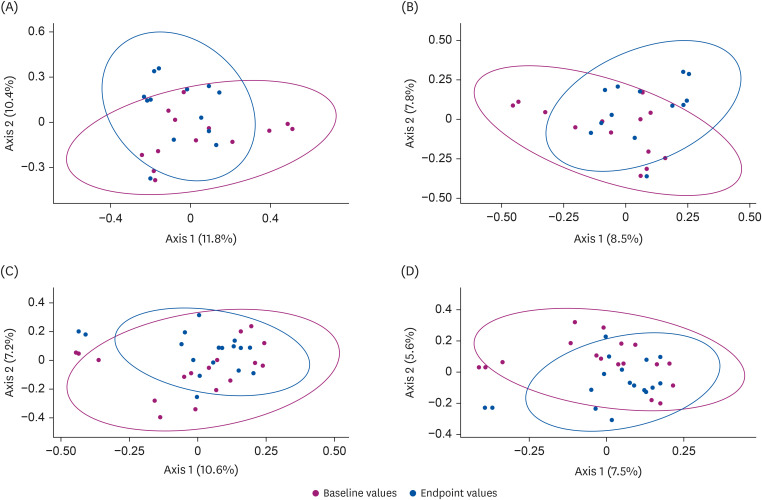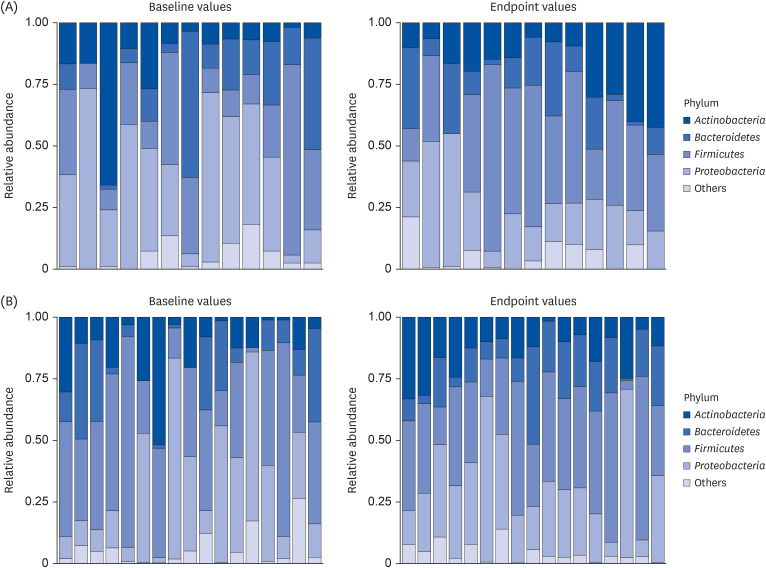1. Shih IL, Van YT. The production of poly-(gamma-glutamic acid) from microorganisms and its various applications. Bioresour Technol. 2001; 79:207–225. PMID:
11499575.
2. Tanimoto H, Fox T, Eagles J, Satoh H, Nozawa H, Okiyama A, Morinaga Y, Fairweather-Tait SJ. Acute effect of poly-gamma-glutamic acid on calcium absorption in post-menopausal women. J Am Coll Nutr. 2007; 26:645–649. PMID:
18187428.
3. Lee SW, Park HJ, Park SH, Kim N, Hong S. Immunomodulatory effect of poly-γ-glutamic acid derived from
Bacillus subtilis on natural killer dendritic cells. Biochem Biophys Res Commun. 2014; 443:413–421. PMID:
24309101.
4. Oyunbileg E, Jun N, Yoon D, Baik I. Effects of poly–gamma–glutamic acid on inflammatory and metabolic biomarkers in sleep–restricted rats. Sleep Biol Rhythms. 2018; 16:399–404.
5. Araki R, Fujie K, Yuine N, Watabe Y, Maruo K, Suzuki H, Hashimoto K. The possibility of suppression of increased postprandial blood glucose levels by gamma-polyglutamic acid-rich natto in the early phase after eating: a randomized crossover pilot study. Nutrients. 2020; 12:915. PMID:
32230729.
6. García-García C, Baik I. Effects of poly-gamma-glutamic acid and vitamin B
6 supplements on sleep status: a randomized intervention study. Nutr Res Pract. 2021; 15:309–318. PMID:
34093972.
7. Jin HE, Choi JC, Lim YT, Sung MH. Prebiotic effects of poly-gamma-glutamate on bacterial flora in murine gut. J Microbiol Biotechnol. 2017; 27:412–415. PMID:
27974732.
8. Umeda K, Ikeda A, Uchida R, Sasahara I, Mine T, Murakami H, Kameyama K. Combination of poly-γ-glutamic acid and galactooligosaccharide improves intestinal microbiota, defecation status, and relaxed mood in humans: a randomized, double-blind, parallel-group comparison trial. Biosci Microbiota Food Health. 2023; 42:34–48. PMID:
36660591.
9. Liang X, Dai N, Sheng K, Lu H, Wang J, Chen L, Wang Y. Gut bacterial extracellular vesicles: important players in regulating intestinal microenvironment. Gut Microbes. 2022; 14:2134689. PMID:
36242585.
10. Samra M, Nam SK, Lim DH, Kim DH, Yang J, Kim YK, Kim JH. Urine bacteria-derived extracellular vesicles and allergic airway diseases in children. Int Arch Allergy Immunol. 2019; 178:150–158. PMID:
30415264.
11. Park JY, Kang CS, Seo HC, Shin JC, Kym SM, Park YS, Shin TS, Kim JG, Kim YK. Bacteria-derived extracellular vesicles in urine as a novel biomarker for gastric cancer: integration of liquid biopsy and metagenome analysis. Cancers (Basel). 2021; 13:4687. PMID:
34572913.
12. Grange C, Dalmasso A, Cortez JJ, Spokeviciute B, Bussolati B. Exploring the role of urinary extracellular vesicles in kidney physiology, aging, and disease progression. Am J Physiol Cell Physiol. 2023; 325:C1439–C1450. PMID:
37842748.
13. Kaisanlahti A, Salmi S, Kumpula S, Amatya SB, Turunen J, Tejesvi M, Byts N, Tapiainen T, Reunanen J. Bacterial extracellular vesicles - brain invaders? A systematic review. Front Mol Neurosci. 2023; 16:1227655. PMID:
37781094.
14. Ministry of Health and Welfare, The Korean Nutrition Society. 2020 Dietary Reference Intakes for Koreans. Sejong: Ministry of Health and Welfare;2020.
15. Ministry of Food and Drug Safety. Current Status of Functional Ingredients for Health Functional Food in Korea. Cheongju: Ministry of Food and Drug Safety;2016.
16. Shin C, Baik I. Bacterial extracellular vesicle composition in human urine and the 10-year risk of abdominal obesity. Metab Syndr Relat Disord. 2023; 21:233–242. PMID:
37134220.
17. Sommer F, Anderson JM, Bharti R, Raes J, Rosenstiel P. The resilience of the intestinal microbiota influences health and disease. Nat Rev Microbiol. 2017; 15:630–638. PMID:
28626231.
18. Manichanh C, Rigottier-Gois L, Bonnaud E, Gloux K, Pelletier E, Frangeul L, Nalin R, Jarrin C, Chardon P, Marteau P, et al. Reduced diversity of faecal microbiota in Crohn’s disease revealed by a metagenomic approach. Gut. 2006; 55:205–211. PMID:
16188921.
19. Turnbaugh PJ, Hamady M, Yatsunenko T, Cantarel BL, Duncan A, Ley RE, Sogin ML, Jones WJ, Roe BA, Affourtit JP, et al. A core gut microbiome in obese and lean twins. Nature. 2009; 457:480–484. PMID:
19043404.
20. Lambeth SM, Carson T, Lowe J, Ramaraj T, Leff JW, Luo L, Bell CJ, Shah VO. Composition, diversity and abundance of gut microbiome in prediabetes and type 2 diabetes. J Diabetes Obes. 2015; 2:1–7.
21. Chen LL, Abbaspour A, Mkoma GF, Bulik CM, Rück C, Djurfeldt D. Gut microbiota in psychiatric disorders: a systematic review. Psychosom Med. 2021; 83:679–692. PMID:
34117156.
22. Wang Z, Wang Z, Lu T, Chen W, Yan W, Yuan K, Shi L, Liu X, Zhou X, Shi J, et al. The microbiota-gut-brain axis in sleep disorders. Sleep Med Rev. 2022; 65:101691. PMID:
36099873.
23. Spychala MS, Venna VR, Jandzinski M, Doran SJ, Durgan DJ, Ganesh BP, Ajami NJ, Putluri N, Graf J, Bryan RM, et al. Age-related changes in the gut microbiota influence systemic inflammation and stroke outcome. Ann Neurol. 2018; 84:23–36. PMID:
29733457.
24. Crovesy L, Masterson D, Rosado EL. Profile of the gut microbiota of adults with obesity: a systematic review. Eur J Clin Nutr. 2020; 74:1251–1262. PMID:
32231226.
25. Morwani-Mangnani J, Giannos P, Belzer C, Beekman M, Eline Slagboom P, Prokopidis K. Gut microbiome changes due to sleep disruption in older and younger individuals: a case for sarcopenia? Sleep (Basel). 2022; 45:zsac239.
26. Poroyko VA, Carreras A, Khalyfa A, Khalyfa AA, Leone V, Peris E, Almendros I, Gileles-Hillel A, Qiao Z, Hubert N, et al. Chronic sleep disruption alters gut microbiota, induces systemic and adipose tissue inflammation and insulin resistance in mice. Sci Rep. 2016; 6:35405. PMID:
27739530.
27. Gottesmann C. GABA mechanisms and sleep. Neuroscience. 2002; 111:231–239. PMID:
11983310.
28. Yu X, Ye Z, Houston CM, Zecharia AY, Ma Y, Zhang Z, Uygun DS, Parker S, Vyssotski AL, Yustos R, et al. Wakefulness is governed by GABA and histamine cotransmission. Neuron. 2015; 87:164–178. PMID:
26094607.
29. Sarasa SB, Mahendran R, Muthusamy G, Thankappan B, Selta DR, Angayarkanni J. A brief review on the non-protein amino acid, gamma-amino butyric acid (GABA): its production and role in microbes. Curr Microbiol. 2020; 77:534–544. PMID:
31844936.
30. Park KB, Oh SH. Enhancement of gamma-aminobutyric acid production in Chungkukjang by applying a Bacillus subtilis strain expressing glutamate decarboxylase from Lactobacillus brevis. Biotechnol Lett. 2006; 28:1459–1463. PMID:
16955351.
31. Yoon DW, Baik I. Oral administration of human-gut-derived
Prevotella histicola improves sleep architecture in rats. Microorganisms. 2023; 11:1151. PMID:
37317125.
32. Yang J, Shin TS, Kim JS, Jee YK, Kim YK. A new horizon of precision medicine: combination of the microbiome and extracellular vesicles. Exp Mol Med. 2022; 54:466–482. PMID:
35459887.









 PDF
PDF Citation
Citation Print
Print





 XML Download
XML Download